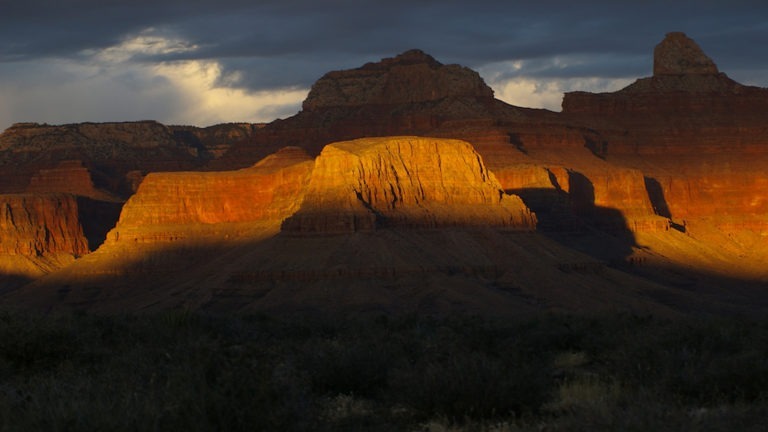Hollow Earth Theory; Is The Subterranean Civilization of Agartha Real?

Is there evidence of a civilization deep beneath the Earth’s surface, or even an atmosphere capable of harboring life? While a lot of the information we receive from NASA and environmental agencies may be accurate, there is still much to be discovered about our planet.
Until more recent times, many people were convinced our planet was a hollow shell with a civilization of Earthly ancients residing underground. The French novelist Jules Verne, known for his series Voyages Extraordinaires, wrote Journey to The Center of the Earth around the time that the belief in a subterranean society piqued.
Before Verne, the hollow Earth concept was originally proposed in the 17th century by Edmond Halley, discoverer of the eponymous short-orbit comet that swings past Earth every 75 years or so. Halley believed the Earth consisted of several concentric shells separated by individual atmospheres, with the outermost layer having a thickness of about 500 miles. Halley believed natural phenomena like the Aurora Borealis and magnetic field variance were products of these multiple layers, which he said moved independently of each other.

More than a century later, Halley’s theory was expounded on by John Cleves Symmes, who published a paper detailing his intent to travel to the Earth’s interior. Symmes devoted the rest of his life garnering support for a hollow earth expedition, but fell sick during a trip to Quebec to give a lecture on his theory. Though he died before his journey ever came to fruition, his ambition inspired Arctic exploration and the first trip to Antarctica in 1838.
Admiral Byrd and the Hollow Earth Expedition
Fast forward another century, between the time of the Great Depression and WWII, as Admiral Richard E. Byrd of the U.S. Navy pioneered further exploration of the poles. And after a multitude of trips to the arctic territories, there is one Byrd narrative that sticks out more than the rest: his record-setting flight over the North Pole.
According to an alleged diary entry written during his polar flight, Byrd came across a warm, lush climate with Mammoth-like creatures and an ancient human race that had been residing within the Earth.
His plane was commandeered mid-air and landed for him by people in the center of the Earth who intercepted his plane with saucer-shaped aircraft. Upon landing, he was met by emissaries of a civilization many assume to be the mythical Agartha. These alleged Agarthans expressed their concern about humanity’s use of atomic bombs during WWII and employed Byrd as their ambassador to return to the U.S. government and relay their sentiment.

The striking issue regarding the validity of this diary entry is that it is dated February 1947. If it is to be believed this story covers Byrd’s inaugural flight over the North Pole, then one need only look at the actual date when he achieved this feat more than 20 years earlier on May 9, 1926. In fact, upon further inspection, it appears Byrd probably didn’t quite reach the North Pole and instead fabricated his navigation records, poaching credit from another team that actually set the record a few days later.
But what makes this entry so intriguing is that, if it is real, could it have potentially been misconstrued from a later mission to Antarctica? Is it actually referring to the notorious Operation Highjump?
Highjump was one of the largest operations ever conducted in Antarctica with over 4,000 men sent to study, map, and reside on the continent for eight months. The expedition included 13 Navy support ships, an aircraft carrier, helicopters, flying boats, and an array of more traditional aircraft.
This expedition, as well as the subsequent Operation Deep Freeze eight years later, established an American military presence on Antarctica, which is prohibited today. So why, exactly, was there such a rush to facilitate this occupation?
Byrd later told a reporter for the Chilean newspaper, El Mercurio, that his expedition taught him the U.S. should “prepare for the possibility of hostile planes coming from the polar regions” as part of a “recapitulation of his own polar experience.” Many took this to be evidence of the flying craft he saw coming from what is believed to have been Agartha.
Were the Nazis at the Center of the Earth?
Other speculation regarding Byrd’s supposed search for Agartha notes a Nazi presence in arctic territory, both North and South. It is well-documented that the Nazis explored arctic regions to set up bases and test novel weaponry, but it is also well-documented that Hitler and the Nazis were obsessed with esotericism and the occult.
The rabbit hole goes deep here, with some going so far as to posit that Hitler could have escaped to this underground world, though that might be counter-intuitive if an ancient enlightened society resided down there.
Nazi maps believed to be instructions for reaching Agartha have supposedly been corroborated by a letter from a German U-boat navigator named Karl Unger, who claims U-209 made it to Agartha and that the Earth is in fact, hollow. The letter also mentions the notorious German Gens. Karl Haushofer and Rudolf Hess, who he says were correct about the hollow-Earth theory.

There is ample evidence the Nazis spent a lot of resources searching for Agartha as a last resort for Hitler to escape in case of dire emergency, somewhat warranting these conspiracies. In fact, the most common diagram of Agartha was drawn by a German scientist in 1935.
Evidence also exists to indicate the Nazis may have believed we already lived on the inside of the Earth. Some experiments of the Third Reich show a belief the Earth was concave, and that we reside on the interior of a sphere.
In a bizarre 1942 experiment conducted by Nazi scientist Heinz Fisher on the island of Rügen, a team attempted to observe a British fleet by pointing the lenses of their infrared equipment up at a 45-degree angle. They believed that, though the Earth was concave, normal rays were refracted off the ocean, but infrared rays were not. Of course, they saw only the sky, but this shows that they believed and searched for evidence of alternative Earth theories.
Agartha Proof in Ancient Cultures
Almost every ancient culture has a story or allusion to the inner realms of Earth, as well as civilizations or people in the center of the Earth. Many of these are places of purgatory where dead spirits reside, rather than a society currently flourishing. The Greeks spoke of Hades, the Christians refer to it as Hell, and in Judaism it is referred to as Sheol. But most of these underground domains were more allegorical and religious tools used to deter people from sinning rather than realms actively being sought out.
There are, however, closer depictions of Agartha described by some cultures with related cities and passageways to get there. In Tibetan Buddhism, there is the secret, mystical city of Shambhala located somewhere deep in the Himalayas that many have searched for, including Russian mystic Nicholas Roerich, though no one is known to have found it. Some believe Shambhala could potentially be connected to Agartha.

In Hindu and Celtic lore — which some believe shared an ancient connection through a lost antediluvian city — there are caves and underground entrances to sub-terrestrial worlds. Some have connected the Hindu land of Āryāvarta, or “abode of the excellent ones,” a land ruled by a supernal race thousands of years before the great war laid out in the Mahabharata. Many believe this ancient race to be of the same lineage as the ancient civilizations from Atlantis, Lemuria, and Mu that were wiped out by war and cataclysmic events, driving them underground to Agartha.
There is another underworld in the Hindu Mahabharata known as Patala that others point to, as it shares many similarities with depictions of a subterranean world, though it is said they are at war with the Agarthans. Patala is the seventh layer of the underworld in Hindu scriptures and is ruled by the nagas, a half-human, half-reptilian species who are depicted with jeweled hoods that light their realm. The Naga are a highly advanced race with cutting-edge technology. Occasionally they are said to abduct, torture and kill humans, though other accounts refer to them as having a positive impact on Earthly events.
Will we ever find out if there exists an underground civilization below the surface of the Earth? There have been attempts to drill down as far as possible to see what’s there, and the Kola Superdeep Borehole made it about 7 miles. The Russian team that led the operation didn’t find Agartha, though it would likely be much further down.
What they did find showed we really don’t know exactly what’s down there. Many of our theories were proven wrong, and we learned a lot more about the Earth’s crust. For one, there was a layer of basalt, known as the Conrad Discontinuity, completely missing, while the presence of water was detected where it shouldn’t have been. This just goes to show: We don’t really know what’s down there.
Mysteries of the Grand Canyon: Pyramids and Ancient Civilizations

Below the Utah/New Mexico border, running along the Western edge of sprawling Navajo, Havasupai, and Hualapai reservations lands, the Colorado River has patiently carved a geological masterpiece — the Grand Canyon. Despite the extreme desert climate, native people have inhabited the region for centuries.
Dominating the landscape beyond the Rocky Mountains, the immense Colorado Plateau stretches 130,000 square miles from the Wyoming border to the North, the Arizona/Nevada border to the East, and beyond the Four Corners region along the Colorado/New Mexico border further East.
A thorough exploration of the region would take months — even years. The Grand Canyon alone could take weeks to explore, beyond requisite tourist attractions. The Havasupai people have lived in the canyon for at least 800-years, and have successfully fought for restoration of tribal lands taken by the federal government. A travertine dome near the confluence of the Colorado and Little Colorado rivers is believed to be the “sipapu,” or “place of emergence” by native people. This sacred formation is nameless, simply referred to as sipapu by indigenous people. Tribal leaders prefer to keep the location private.”




































